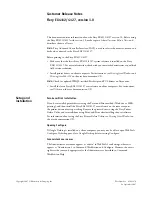
General memory module installation guidelines
To ensure optimal performance of your system, observe the following general guidelines when configuring your system memory.
If your system's memory configurations fail to observe these guidelines, your system might not boot, stop responding during
memory configuration, or operate with reduced memory.
The memory bus may operate at speeds of 3200 MT/s, 2933 MT/s , or 2666 MT/s depending on the following factors:
●
System profile selected (for example, Performance Optimized, or Custom [can be run at high speed or lower])
●
Maximum supported DIMM speed of the processor
●
Maximum supported speed of the DIMMs
NOTE:
MT/s indicates DIMM speed in MegaTransfers per second.
The system supports Flexible Memory Configuration, enabling the system to be configured and run in any valid chipset
architectural configuration. The following are the recommended guidelines for installing memory modules:
●
All DIMMs must be DDR4.
●
x4 and x8 DRAM based memory modules can be mixed.
●
If memory modules with different speeds are installed, they operate at the speed of the slowest installed memory module(s).
●
Populate memory module sockets only if a processor is installed.
●
In Optimizer Mode, the DRAM controllers operate independently in the 64-bit mode and provide optimized memory
performance.
Table 29. Memory population rules
Processor
Configuration
Memory population
Memory population
information
Single processor
Optimizer (Independent
channel) population order
A{1}, A{2}, A{3}, A{4}, A{5}, A{6},
A{7}, A{8}
1, 2, 4, 6, 8 DIMMs are
allowed.
●
Memory modules of different capacities can be mixed provided other memory population rules are followed.
NOTE:
For example, 8 GB and 16 GB memory modules can be mixed.
●
Mixing of more than two memory module capacities in a system is not supported.
●
Unbalanced or odd memory configuration results in a performance loss and system may not identify the memory modules
being installed, so always populate memory channels identically with equal DIMMs for best performance.
●
Odd memory configuration with 3, 5 or 7 RDIMMs/LRDIMMs is not supported.
●
Supported RDIMM / LRDIMM configurations are 1, 2, 4, 6, 8 DIMMs.
●
Mixing RDIMM and LRDIMM is not supported.
Intel Optane PMem 200 Series installation guidelines
The following are the recommended guidelines for installing Intel Optane PMem 200 Series memory modules:
●
Each system supports maximum of one Intel Optane PMem 200 Series memory module per channel.
●
Intel Optane PMem 200 Series can be mixed with RDIMM or LRDIMM.
●
Mixing of Intel Optane PMem 200 Series operating modes (App Direct, Memory Mode) is not supported.
●
Intel Optane PMem 200 Series cannot be mixed with other Intel Optane PMem 200 Series capacities or NVDIMMs.
●
Mixing RDIMMs and LRDIMMs are not allowed when Intel Optane PMem 200 Series is installed.
●
VMware ESXi boot takes a longer time when Intel Intel Optane PMem 200 Series are configured in AppDirect mode. This
is expected as background ARS is going on the interleave sets and needs to be completed before the pMem datastore is
mounted on ESXi.
●
Intel Optane PMem 200 Series in App Direct mode can be populated symmetrically or asymmetrically across sockets.
●
In Memory mode symmetry across sockets is required.
For more information about the supported Intel Optane PMem 200 Series configurations, see the
Dell EMC Intel Optane PMem
200 Series User 's Guide
at
https://www.dell.com/support/home/products/server_int/server_int_poweredge
80
Installing and removing system components
















































